It was a stormy afternoon today.
My beautiful wife snapped this uncanny image of the stormy sky a few hours ago.
No, it is not a black-and-white photograph. These were the actual colors.
What a planet we live on. Wow.
I first bought a hybrid (a Honda Civic) in 2004. I loved that car; it served us faithfully for 10 years. Our more recent Hondas were not hybrids, but the reasons were eminently practical: hybrids were in short supply, conventional gasoline cars were cheaper, and we use the car very little in any case, so…
Having said that, I certainly contemplated the idea of buying an all electric vehicle, but every time I think it through, I decide against it. Today, I saw a map that perfectly illustrates my lack of enthusiasm. Here it is:

This map shows the locations of supercharger stations where you’d have to stop for a 20-30 minute recharge, in order to complete a cross-country trip across the United States in a Tesla automobile.
In contrast, here’s a map of an actual trip I took in my Civic Hybrid back in 2005, along with the approximate locations where I stopped for gas (reconstructed from old receipts):
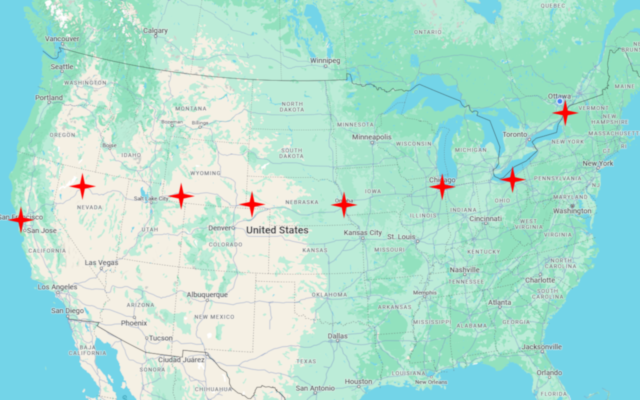
What can I say? I think EVs are great when you live in the suburbs and use your car for shopping and commuting to work. If I lived, say, in Kanata and commuted daily to work at, say, Place du Portage in Gatineau, purchasing an EV would make an awful lot of sense. But that’s not where we live or how we commute. We live on Ottawa Lowertown, which is to say almost downtown, we work at home, we use the car only occasionally, but as this example demonstrates, sometimes for lengthy road trips. EVs are not great for lengthy road trips. I am used to the idea of driving to Montreal Airport and back without worrying about stopping for gas. Or driving to Toronto non-stop.
And then, of course, there are the dreaded Canadian winters. It’s one thing to use waste heat from a gasoline engine to heat the interior of a car. It’s another thing to waste electric power stored in a battery for this, converting electricity inefficiently into heat, at the expense of range already reduced by the effect of cold weather on the batteries. And while heat pumps can help, there are no miracles when the outside air temperature is closer to -40 than -30 Centigrade, which is a not altogether uncommon occurrence (though it is certainly becoming less common) in these parts of Canada.
And then there’s the question of where the electric energy comes from. Renewables are okay, nuclear would be great. But too much of the electricity, even here in nuclear-rich Ontario, comes from natural gas fired plants. That’s not so great.
So for now, it’s either gasoline-powered or hybrid vehicles for us. EVs may be in our future, but I am not yet too keen on them, to be honest.
A few days ago, I came across an article that described a remarkable paper, published in the USSR more than 50 years ago, with predictions on climate change.
Predictions that proved remarkably prescient.
I first read about Mikhail Budyko’s article in a recent review, published on EOS three years ago. What caught my attention, in particular, was Fig. 1 of that article, reproduced below, that shows just how spot on Budyko’s predictions happen to be.

Naturally, I wanted to see the original reference, which proved harder than I expected. While it was cited many times, the paper was almost impossible to find. Although I did locate it in an online Russian library, it was only an index entry, with the (unscanned) copy available only for reading in person.
But then… Fortunate favors the… foolish? Persistent? I stumbled upon a 2020 Russian-language publication containing full reprints of several papers by Mikhail Budyko, including the paper in question.
I took it upon myself then to translate the paper in its entirety, with help from one of our AI friends. (AI can do a remarkable job translating technically challenging content, much better than dedicated translation software, albeit some supervision is required.)
Yes, Budyko indeed accurately predicted human-induced climate change. His concerns about rapid changes, “tipping points” are also well-justified. Notably, his work was written before climate change became political football. It’s the work of an excellent climate scientist, not a political hack.
Here’s my phone screen as of a few minutes ago:
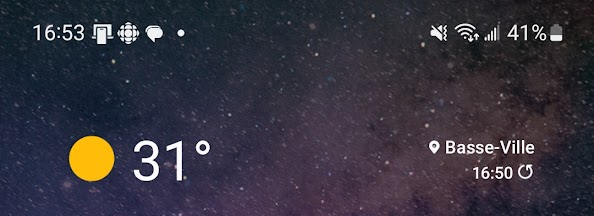
That’s in Centigrade of course.
What can I say? OK, our balcony thermometer only shows 28.3 C. Even so… not exactly typical early October weather for Ottawa.
And then there is this. The rate of increase in atmospheric methane has been rising since the mid-2000s. The curve is becoming ever steeper.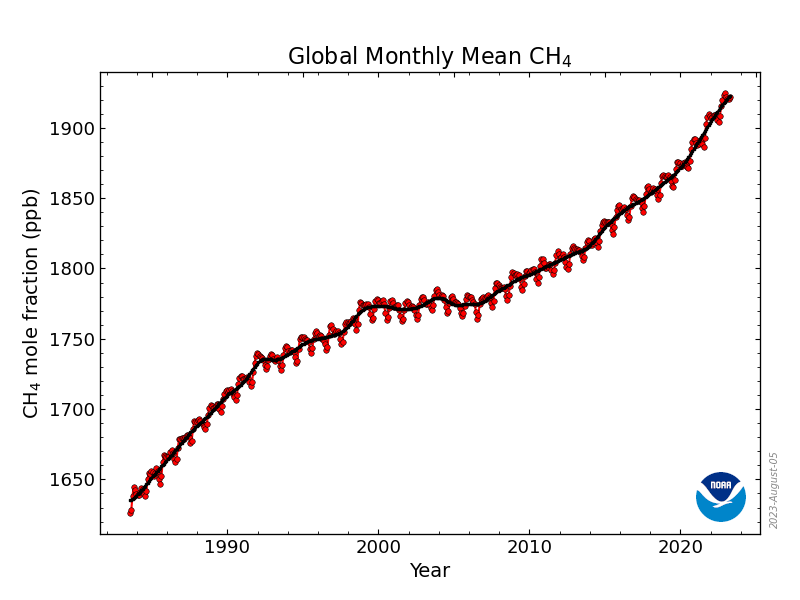
Surprisingly perhaps, it’s not from natural gas producers, industry, or vehicles. Not even cow farts.
It’s apparently in large part coming from tropical wetlands. Climate change is still indirectly responsible as it is the changing climate that changes the vegetation that, in turn, results in more methane production. But the consequences of this rise in methane levels can dwarf anything CO2 will do. A “termination-level” event, they call it, which sounds alarming and it should be: even though it does not mean our immediate termination, it may mark the termination of an epoch, just as in the past, when similar rises in methane events marked the end of the ice ages. Except that there’s no ice age at present.
Yellowknife is not a large city by Ontario standards, but it is the capital city and the largest community in the Northwest Territories of Canada, with over 20,000 inhabitants.
And it is about to be evacuated entirely today, because of the imminent wildfire threat.
Yes, it’s a faraway place but it is still incredibly scary that tens of thousands of Canadians are uprooted, some taking their cars, some boarding evacuation buses or flights, fleeing their homes, traveling through landscapes that are like warzones, with burned buildings and burnt-out vehicles often in sight.
No, I won’t rant about climate change. There can be other contributing reasons behind this unprecedented wildfire season, though I bet climate change is by far the most significant contributor.
I wonder what prompted N.W.T. authorities to take this drastic step. I may be wrong but I have a feeling that the devastation in Maui was a wake-up call, and they wanted to avoid a similar disaster. Having said that, I sincerely hope that Yellowknife will be spared and its inhabitants can return in a few days.
I don’t usually like climate panicmongering but this chart that I came across today is… Well, see for yourself.
These are ocean temperatures, by the way. Oceans are supposed to be large, stable reservoirs of heat. Which they probably are, except that surface temperatures also reflect changing patterns like changing ocean currents.
This massive deviation from the 20+ year average (more than four sigmas!) is difficult to comprehend. What it says about the changing climate, I have no idea, but it is unlikely to be good news.
If only we stopped making this political. OK, well, it is of course political in the sense that we need to make collective, i.e., political decisions on how we manage Spaceship Earth. But it should not be political in the sense that the facts are not political, and the proposed solutions should be weighed by their feasibility, efficacy and social impact, not political palatability.
And for heaven’s sake, stop the dumbed down oversimplifications. Next time I hear about someone emitting “carbon”, I’ll scream. Carbon is solid at room temperature. Carbon is not carbon dioxide, just as hydrogen is not dihydrogen oxide. I have yet to see anyone drinking liquid hydrogen… or emitting carbon. Perhaps the first step to take is to give people a more decent education in the sciences so that they actually understand what carbon dioxide is, what it does in the atmosphere, what “four sigma” means, and what things like heat reservoirs are in a climate system? Is that really too much to ask? Am I being a silly elitist or something?
Once again, we have summer in April.
This picture shows the melting pile of dirty snow in our visitor parking area, photographed from our upstairs bedroom window.
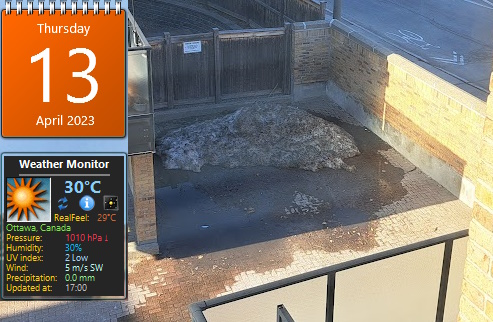
The date and the temperature widget speak for themselves. (Yes, I still use Windows widgets, through a third-party tool. What can I say? I like them.)
Today is November 5, 2022. Here we are in Ottawa, supposedly the second coldest capital city in the world after Ulan Bator. It is 9:15 PM.
And it is 21 degrees (centigrade — 70 F, for my American friends.)
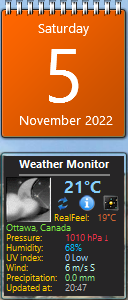
Our A/C ran several times today, especially while we were baking something.
This is beyond incredible. I’ve seen snowstorms in this town in October. I’ve never seen summer-like weather in November.
If this is global warming… well, if folks who will likely be swept away by the sea in places like Florida don’t care, who am I to complain?
Still… weather like this in November is a bit creepy.
[And yes, I still use Windows gadgets, with the help of third-party software. What can I say? I like them.]
Doesn’t this cloud, photographed in the skies above Ottawa by my beautiful wife moments ago, look just like the USS Enterprise?
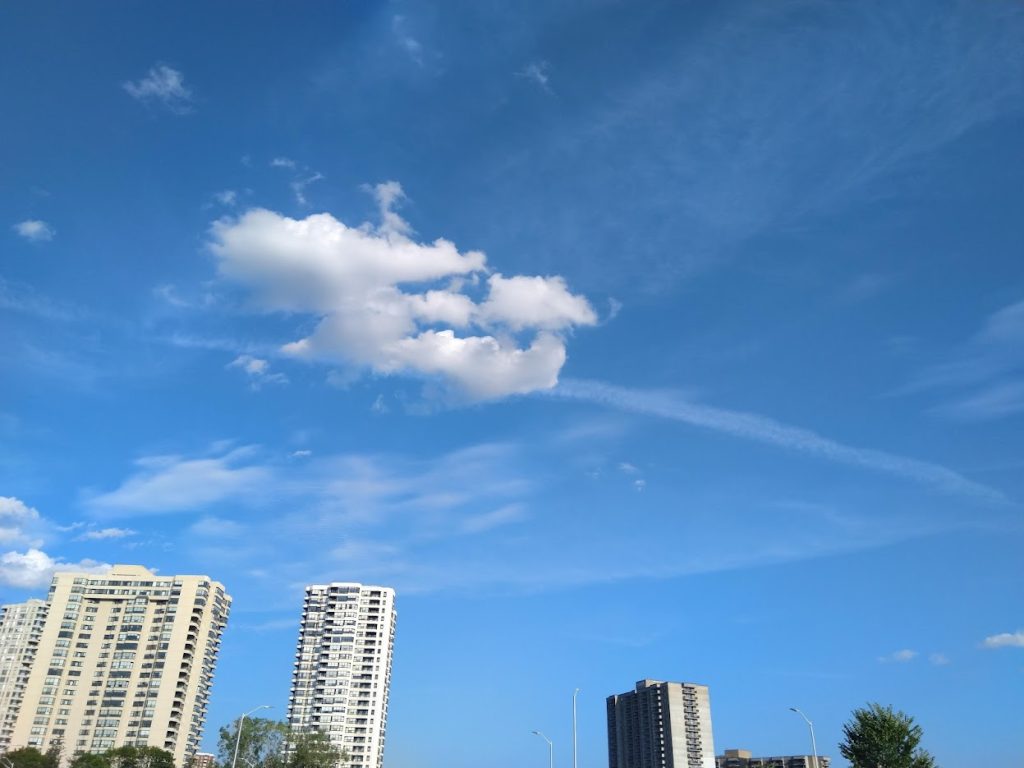
Maybe it is, doing its time-traveling thing, with a malfunctioning cloaking device.
Saturday afternoon was stormy. The lights flickered a bit during the storm, my UPSs came online several times. But then the storm left, and everything was back to normal.
At least here in Lowertown.
I didn’t check the news, so it was not until later Sunday that I learned, from a social media post from a friend who has been without power since, just how bad things really got.
And how bad they still are.
Hydro Ottawa’s map is still mostly red. Now “only” about 130,000 customers are affected, which is certainly less than the peak of well over 170,000, but to put that into perspective, Hydro Ottawa has a total of less than 350,000 customers; that means that at one point, more than half the city was without power.
As a Hydro official said on CTV News tonight, their distribution system is crushed.
And then there are all the downed trees, destroyed traffic lights, not to mention severely damaged homes and businesses. Not quite a like a war zone (of which we had seen plenty on our TV screens, courtesy of Mr. Putin’s “special military operation” in Ukraine) but close.
And of course the damage doesn’t stop at Hydro Ottawa’s borders: Hundreds of thousands more are without power in Eastern Ontario and also Quebec.
Temperatures like this just do not exist in Canada.
When you hear that the temperature was within a hair’s breadth of 50 degrees centigrade (well over 120 F) you’d think I am talking about a spot in the Sahara Desert. Or maybe the Australian Outback. Or Death Valley.
But no, this temperature was measured earlier today in Lytton, British Columbia, Canada.
It is surreal. Scary. And deadly: apparently, dozen’s of mostly older people succumbed to this heat wave in BC.
A Dallas-Fort Worth TV station characterized Texas as the energy capital of the world as it asked the rhetorical question: How could this happen?
I have friends in Texas. One of them e-mailed me to let me know that they’ve been without power since 5 AM this morning.
Unlike the US-Canadian northeast with its interconnected power grid, Texas has its own power grid. This means, I understand, that they cannot rely on excess generating capacity in neighboring states to help with the crisis.
And the weather is bitterly cold, much colder than up here in wintry Ottawa. Right now, according to that Dallas-Fort Worth TV station it’s 8 degrees Fahrenheit but it will drop to several degrees below zero on the Fahrenheit scale overnight; that’s -20 C for us folks in metric lands.
This is not a joke. In weather like this, people can die, especially in ill-insulated homes as they struggle with unexpected secondary disasters such as bursting, frozen pipes that may very well happen.
This may not be an all-time record-breaking day according to Environment Canada (supposedly, the peak temperature today at Ottawa Airport was 34.8 C at 2 PM) but it sure is hot.
You could be forgiven if you thought that this measurement is of the body temperature of a COVID-19 patient with mild symptoms, not the outdoor temperature on our balcony, measured in the shade:

As I said… really hot. Praise be to air conditioning.
Yes, it can get cold in Toronto. Usually not as cold as Ottawa, but winters can still be pretty brutal.
But this brutal, this late in the season?
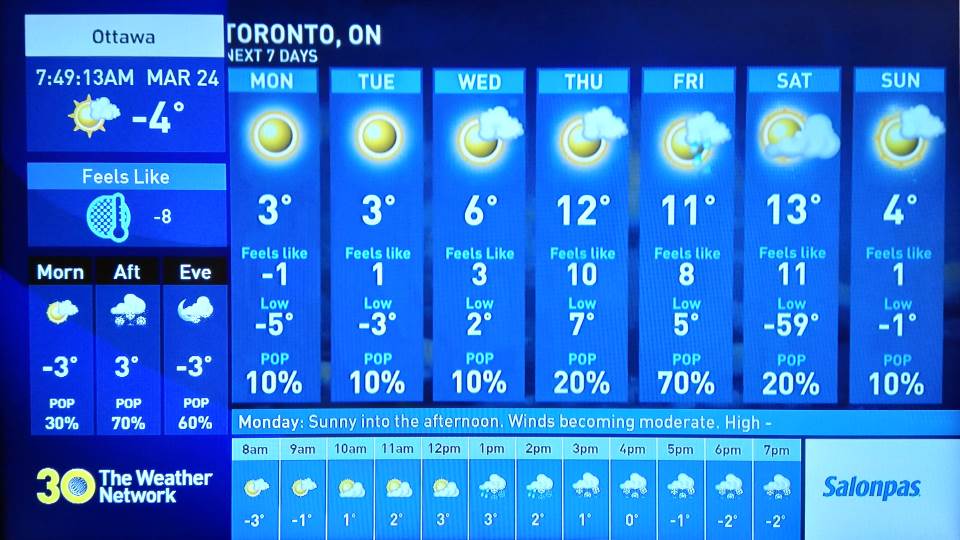
Yes, according to The Weather Network earlier this morning, the temperature overnight will plummet to -59 degrees Centigrade next weekend.
Yikes. Where is global warming when we need it?
I know, I know, it’s not for the weather that we love Canada.
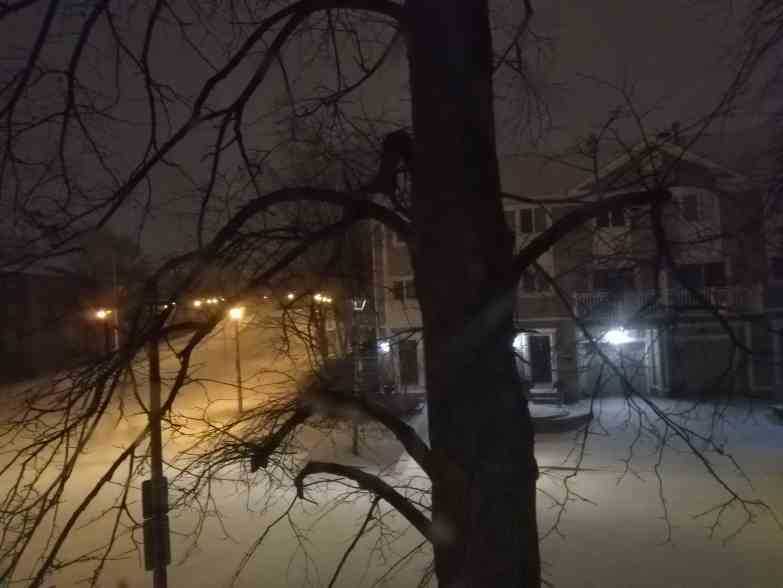
Still… plunging into winter in the middle of November?
No, it isn’t Friday yet.
But it seems that someone at CTV Morning Live wishes it was. Why else would they have told us that yesterday, February 28, was a Thursday? (Either that or they are time travelers from 2019.)

Then again, maybe I should focus on what they are actually saying, not on a trivial mistake they made: that even as parts of Europe that rarely see snow are blanketed by the white stuff, places in Canada and Siberia see unprecedented mild weather. A fluke or further evidence of climate change disrupting the polar vortex?
Interesting forecast, courtesy of the Weather Network earlier this afternoon:
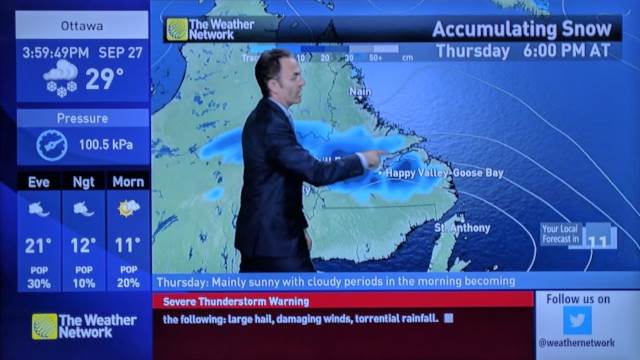
Yes, that is a snow symbol in the upper left corner. And yes, my American friends, the 29 degrees is Centigrade.
Warm snow, I guess.
(The “Accumulating snow” headline for Goose Bay is probably valid. But the upper left corner was supposed to describe current conditions here in Ottawa.)
Today is September 25. In one of the coldest capital cities in the world. Yet this is the temperature according to the weather monitor gadget on my desktop (but also according to the thermometer on our balcony):
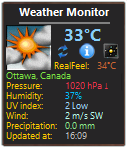
Yes, 3233 C. Or 9091 F for my American friends. The record for this day? A little under 30 C.
No, it does not feel like autumn at all.
On an unrelated note, yes, I do like to use desktop gadgets on Windows 10.